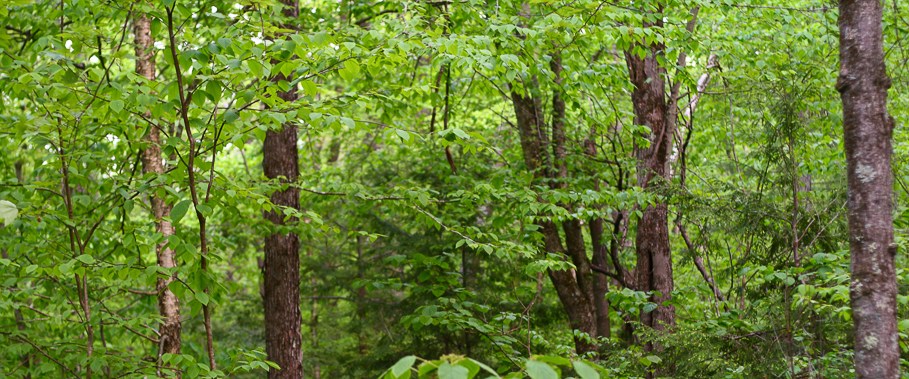Amazon
Understanding tropical vegetation-climate interactions in the Amazon basin.

Long-term eddy flux tower for measuring net ecosystem exchange of CO2 in central eastern Amazon forest of Brazil, with Dr. Natalia Restrepo and Daniel Amaral conducting maintenance
Our current Amazon work — supported by NSF Partnerships for International Research and Education (Amazon-PIRE) and building on the strong legacy of support from NASA — focuses on integrating remote sensing techniques and ground based measurements to extrapolate our understanding of local controls on carbon cycling in old-growth Amazon forest to derive landscape and regional scale carbon balance. The goal of this work is to build upon our ongoing investigations of how forest demography and disturbance dynamics control carbon cycling in old-growth Amazon forest, which uses long-term eddy covariance observations of net ecosystem exchange of CO2, integrated with classical methods of forest ecology.
Our ground-based site is the Tapajus National Forest near Santarum (see figure, above right, of long-term eddy flux tower for measuring net ecosystem exchange of CO2 in this central eastern Amazon forest of Brazil). The net CO2 flux from this tower shows the forest losing carbon, an observation not previously seen in the Amazon that will help reconcile an Amazon carbon-budget problem (See Saleska et al., 2003). The carbon budget problem arose from previous studies showing carbon uptake of 1-3 Pg C yr-1 in Amazu00f4nia alone, comparable to the whole global terrestrial carbon sink.
We collaborated with Chris Martens at UNC to test of the accuracy of our eddy flux measurements using radon gas as a transport tracer (Martens et al., 2004). This work independently confirms our approach to estimating carbon balance using eddy flux measurements.
Forest biometric observations allow us to attribute observed carbon loss to ecological mechanism: disturbance-recovery dynamics thought characteristic of old-growth forest but not yet observed in tropical carbon balance studies. For a good paper on what we are learning from the vegetation dynamics, see Rice et al., 2004 (view pdf), first-authored by an undergraduate who worked with us in Brazil.
This work is part of the Large-Scale Biosphere-Atmosphere Experiment in Amazonia (LBA).
For more details, see the Tapajus project (which I began while I was a post-doc with Steve Wofsy at Harvard University). Data from the project is available.

Detailed measurements on 2600 individual trees in footprint of Amazonian flux tower (Rice et al. 2004). Shown here is a Brazilian forester using a ladder to measure tree diameter above buttresses.
Collaborators and participants on this project include:
- Saleska lab members Dr. Natalia Restrepo, Joost van Haren, Brad Christoffersen, Dr. Luciana Alves, Jin Wu, Tara Woodcock
- PIRE graduate fellows Sarah White, Brian Chaszar, Chris Meehan, Lindsey Hovland, Loren Albert, Jacob Meuth, and Gabriel Moreno
- PIRE Co-Investigators Alfredo Huete, Jim Shuttleworth, and Steven Wofsy (from Harvard University)
- Professors Plinio Camargo, Humberto da Rocha, Paulo Artaxo (University of Sao Paulo, Brazil)
- Cosme Oliveira (Embrapa), and Rodrigo da Silva (Federal University of East-Para), in Santarem
- Dr. Antonio Manzi, and students Lissandra Souza and Suellen Marostica (INPA-Manaus)
- Rafael Oliveira, University of Campinas
- Many others in Brazil, including researchers of the Museu Goeldi (Belem), and the Biological Dynamics of Forest Fragments Project (Manaus).
Using LIDAR remote sensing to scale carbon cycling from individuals to ecosystem in the Amazon
Amazon forests form the largest contiguous intact tropical forest on Earth, a vast storehouse of carbon that could influence the trajectory of global climate change. However, even the present-day carbon balance of Amazonia remains poorly characterized, and the literature vigorously debates whether reports of substantial carbon uptake in study plots present sufficient evidence to reject the null hypothesis that old-growth forests of the Amazon have a landscape-scale carbon balance of zero.

This project seeks to use the first aircraft-based LIDAR remote sensing surveys of Amazon forests to scale forest function from individual trees to the landscape. We aim to develop insight into the fundamental rules governing scaling relationships, and relation between structure and function, in tropical forests, thereby helping, among other things to help resolve the debate about whether intact Amazon forests are a source or a sink for atmospheric CO2.
This project is funded by NSF and NASA, with contribution from Center for Tropical forest Studies (CTFS). Participants in this project includes a significant group of collaborators, including:
- Saleska lab members Scott Stark, Veronika Leitold
- Professor Michael Lefsky (Colorado State University) and NASA graduate fellow Maria Hunter (University of New Hampshire)
- Dr. Yosio Shimabukuro, Dr. Dalton Valeriano, and Monica Shimabukuro (INPE Sao Jose dos Campos)
- Dr. Jess Parker (Smithsonian Environmental Research Center)
- Professors Bill Magnusson and Flavia Costa, and graduate students Juliana Schietti and Diego Brandao (INPA Manaus)
To view photos of research in the amazon click HERE



Recent Comments